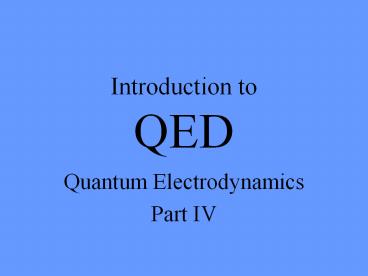Introduction to QED - PowerPoint PPT Presentation
Title:
Introduction to QED
Description:
Baryons have one of each color and mesons have a quark-anti-quark pair. ... bombarded by protons of higher and higher energy, new particles have appeared. ... – PowerPoint PPT presentation
Number of Views:113
Avg rating:3.0/5.0
Title: Introduction to QED
1
Introduction toQED
- Quantum Electrodynamics
- Part IV
2
Applications of QED
- Through the use of atom smashers, over 400
particles have been discovered. - This multitude of particles has created a need to
explain their number and the nature of their
interactions. - QED deals specifically with electrons and
photons, but its form and function can be applied
to other particle interactions.
3
QCD
- A great number of these newly-discovered
particles are simply combinations of quarks. - The quantum theory of the interactions of quarks
via the strong force is called Quantum
Chromodynamics (QCD). - 3 make a baryon and 2 make a meson
4
Elementary Particles
5
Baryons
6
Gluons
- Quarks interact via the gluon.
- The gluon functions in many ways like a photon.
- The probability of a coupling occurring is the
constant g (similar in function to j for
electrons) - Diagrams of interactions will look very similar
to that of the electron and photon.
7
Elementary Particles
8
Quark-Gluon Coupling
9
Color
- Quarks and gluons have a property called color.
- Quarks can change color by coupling with a gluon.
- Colors are red, green, and blue.
10
Change of Color
11
Gluon Coupling
12
Rules of Color
- All particles created by quarks must be
colorless. - Baryons have one of each color and mesons have a
quark-anti-quark pair. - Impossible to have a single quark.
13
Change of Flavor
- A down quark can change into an up quark.
- This is done by emitting a W particle, which then
decays into an electron-anti-neutrino pair. - This process is called beta decay.
14
Beta Decay
15
Elementary Particles
16
Neutral Currents
- There is a particle Z0 that is a neutral W boson.
- Z0 has no charge.
- Couplings with Z0 result in no change in a
particles charge. (Neutral Currents)
17
Z0 Couplings
18
W-Anti-W Coupling
19
Electro-Weak Force
- The observed coupling constant is almost
identical as that of the photon. - The three Ws and the photon would then appear to
be somehow interconnected. - Electrodynamics and the weak force were
successfully combined by Stephen Weinberg and
Abdus Salam
20
Redundant Particles
- As nuclei have been bombarded by protons of
higher and higher energy, new particles have
appeared. - These particles seem to mimic lower-energy
versions and differ only by their higher mass. - E.g. The Muon is identical to an electron, except
its about 200 times heavier.
21
Muon Interactions
22
Beta Decay with a Muon
23
More Elementary Particles
24
Even More Elementary Particles
25
- Diagrams
- Feynman, Richard P. QED The Strange Theory of
Light and Matter. Princeton University Press.
Princeton, NJ, 1988.
26
Questions?































